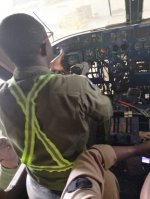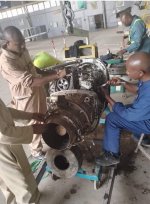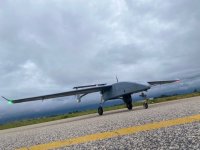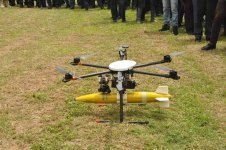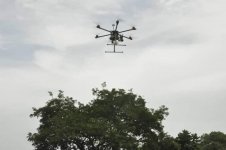The Nigerian Air Force (NAF) is the air branch of the Nigerian Armed Forces. It is the youngest branch of the Nigerian Armed Forces. It is one of the largest in Africa, consisting of over 18,000 personnel as at 2021 and aircraft including 9 Chengdu F-7s, 11Dassault-Dornier Alpha Jets, three JF-17 Thunder Block II and 12 Embraer EMB 314 Super Tucano aircraft, 24 Ameracchi M-346 FAs on order, attack helicopters, armed attack drones, and military transport aircraft.
The head of the German Air Force Assistance Group (GAFAG) was Colonel Gerhard Kahtz, and he became the first commander of the NAF. The nucleus of the NAF was thus established with the formation of the Nigerian Air Force headquarters at the Ministry of Defense.
The NAF did not acquire combat capability until several Mikoyan-Gurevich MiG-17 aircraft were presented by the Soviet Union in support of Nigeria’s war effort during the Nigerian Civil War. On 13 August 1967, following several damaging attacks by Biafran aircraft, the USSR started delivering the first MiG-17s from Egypt to Kano IAP, simultaneously sending a large shipment aboard a Polish merchant ship. Initially two MiG-15UTI (NAF601 and NAF 602), and eight MiG-17 (NAF603 to NAF610) were supplied to Nigeria. Later six Il-28 bombers, initially flown upon deployment by Egyptian and Czech pilots, were delivered from Egypt and stationed at Calabar and Port Harcourt.
During the 1970s, Nigeria bought Lockheed C-130 Hercules from the United States. Six were acquired at a total cost of $45 million. 25 Mikoyan-Gurevich MiG-21MFs and six MiG-21UM were delivered in 1975 upon the advent of the Murtala-Obasanjo administration that replaced the regime of General Yakubu Gowon. Most of these aircraft were deployed, making the NAF one of the most formidable air forces in Africa during this period.
Jimi Peters wrote: '..the 1975-1980 NAF development plan restructured NAF formations' into group (air force) level units that reported to air force headquarters. That structure, he went on, was found too cumbersome, and thus two intermediate commands (military formations) were formed in 1978: NAF Tactical Air Command and NAF Training Command.
From September 2009, Nigeria began refurbishing some of its C-130 aircraft beginning with the NAF 917 which it brought back to life with the support of U.S. Air Forces Africa and 118th Airlift Wing. The NAF has subsequently further improved its domestic capacity with the increase in the serviceability of a good number of its transport aircraft.
On 24 March 2011, the new Air Officer Commanding of NAF Mobility Command, Air Vice Marshal John Aprekuma, explained the rationale behind the establishment of the headquarters of the newly established Air Force Mobility Command in Yenagoa, Bayelsa State as being part of the Federal Government's strategy to protect its socio-economic interest in the Niger Delta, affirming that the presence of the command's headquarters would bring about security and calm to the people of the State.
On 9 December 2011, the Nigerian Air Force commissioned its first female pilot, Blessing Liman, following a directive to the NAF hierarchy by former President Goodluck Jonathan, for the service to start offering flying opportunities to qualified Nigerian female citizens, especially since women had long been flying civil aviation aircraft in the country but did not get a chance to fly in the military.[6]
In March 2014, the Nigerian Government approached Pakistan for the purchase of joint Chinese-Pakistani made CAC/PAC JF-17 "Thunder" multi-role fighter aircraft. In December 2015, the Government of President Muhammadu Buhari presented a budget to the National Assembly that included N5bn for three JF-17 aircraft. On March 28, 2018, 'The Diplomat' reported Pakistan as confirming the sale of three JF-17s to Nigeria. In March 2020, NAF Chief of Air Staff announced the delivery schedule of three JF-17 Thunder to be affected in November 2020. It is understood that the Buhari administration will expand the fleet of JF-17 fighter aircraft upon an expression of satisfaction by NAF Generals, with the performance of the initial batch procured.
In December 2017, NAF formally announced that the United States of America had agreed to sell the A-29 Super Tucano attack aircraft to Nigeria after the deal had previously stalled. The success of this transaction is credited to the persistent negotiation and diplomatic skills of the Buhari administration.
In November 2018, Sierra Nevada was officially awarded the contract for the 12 Super Tucano aircraft for the NAF, with an estimated completion date by 2024.
On 2 January 2019, one Mi-35M attack helicopter from the Nigerian Air Force helicopter squadron crashed in Damasak, Borno State while providing close-air support for troops of the 145 Battalion combating Boko Haram insurgents, killing all onboard. The Mi-35 in the fleet of the NAF is the top-of-the-range model acquired in the life of the administration of President Muhammadu Buhari that had also ordered several Mi-171 and Agusta 109 helicopters from both Mil Moscow Helicopters of Russia and Italy's Leonardo Aerospace for the service.
On 15 October 2019, the NAF winged its first female combat fighter jet pilot, Flight Lieutenant Kafayat Sanni, and its first female combat helicopter pilot Lieutenant Tolulope Arotile. They were amongst thirteen other pilots also winged on the same day.[7][8]
In April 2020, Embraer reported the completion of the first set of Super Tucanos out of the 12 on order, with an expected full delivery in 2021.
The Chief of the Air Staff (CAS) is the principal or lead adviser to the President and also the Minister of Defense and the Chief of Defense Staff, on air-related defense matters. The Nigerian Air Force headquarters is responsible for establishing long and short-term mission objectives and articulating policies, carrying out plans and procedures for the attainment of peace and stability. Also, HQ Nigerian Air Force liaises with the Nigerian Army and Nigerian Navy on joint operational policies and plans. The headquarters Nigerian Air Force consists of the office of the Chief of the Air Staff and 8 staff or branches namely; Policy and Plans Branch, Operations Branch, Air Engineering Branch, Logistics Branch, Administration Branch, Accounts and Budget Branch, Inspections Branch and Air Secretary Branch respectively. Each of these branches is headed by an Air Vice Marshal as branch chief.
Nigerian Air Force Tactical Air Command (TAC), with its headquarters situated at Makurdi, is responsible for interpreting, implementing and controlling Nigerian Air Force operational plans.
Nigerian Air Force Mobility Command, headquartered at Yenagoa, was established in 2011. It has five other commands located in Lagos, Ilorin, Calabar, Warri and Abuja. The Mobility Command performs tactical and strategic airlift in support of government and military operations.
Nigerian Air Force Training Command, located at Old Kaduna Airport, is chiefly responsible for the training of recruits, ground support crew, and technicians.
Nigerian Air Force Logistics Command, headquartered at Ikeja, Lagos, is tasked to acquire, maintain and sustain equipment in a state of operational readiness and at a minimum cost consistent with Nigerian Air Force mission requirements.

 en.wikipedia.org
en.wikipedia.org
History
Although an Air Force was originally proposed in 1958, many lawmakers preferred to rely on the United Kingdom for air defense.[citation needed] But during peacekeeping operations in Congo and Tanganyika, the Nigerian Army had no air transport of its own, and so in 1962, the government began to recruit cadets for pilot training in various foreign countries, with the first ten being taught by the Egyptian Air Force.[1960s
The Nigerian Air Force was formally established on 18 April 1964 with the passage of the Air Force Act 1964 by the National Assembly. The Act stated that the "Nigerian Air Force shall be charged with the defense of the Federal Republic by air, and to give effect thereto, the personnel shall be trained in such duties as in the air as well as on the ground." The NAF was formed with technical assistance from then West Germany (now Federal Republic of Germany following the reunification of West and East Germany). The air force started life as a transport unit with the first air crew trained with the Ethiopian Air Force, the second set of undergo training in February 1963 with Royal Canadian Air Force while some were sent to the Indian Air Force.The head of the German Air Force Assistance Group (GAFAG) was Colonel Gerhard Kahtz, and he became the first commander of the NAF. The nucleus of the NAF was thus established with the formation of the Nigerian Air Force headquarters at the Ministry of Defense.
The NAF did not acquire combat capability until several Mikoyan-Gurevich MiG-17 aircraft were presented by the Soviet Union in support of Nigeria’s war effort during the Nigerian Civil War. On 13 August 1967, following several damaging attacks by Biafran aircraft, the USSR started delivering the first MiG-17s from Egypt to Kano IAP, simultaneously sending a large shipment aboard a Polish merchant ship. Initially two MiG-15UTI (NAF601 and NAF 602), and eight MiG-17 (NAF603 to NAF610) were supplied to Nigeria. Later six Il-28 bombers, initially flown upon deployment by Egyptian and Czech pilots, were delivered from Egypt and stationed at Calabar and Port Harcourt.
1970s
In July 1971, the International Institute for Strategic Studies estimated that NAF had 7,000 personnel and 32 combat aircraft: six Ilyushin Il-28 medium bombers, eight MiG-17, eight Aero L-29 Delfín jet trainers, and 10 P-149D trainers. Other aircraft included six C-47, 20 Do-27/28, and eight Westland Whirlwind and Alouette II helicopters.During the 1970s, Nigeria bought Lockheed C-130 Hercules from the United States. Six were acquired at a total cost of $45 million. 25 Mikoyan-Gurevich MiG-21MFs and six MiG-21UM were delivered in 1975 upon the advent of the Murtala-Obasanjo administration that replaced the regime of General Yakubu Gowon. Most of these aircraft were deployed, making the NAF one of the most formidable air forces in Africa during this period.
Jimi Peters wrote: '..the 1975-1980 NAF development plan restructured NAF formations' into group (air force) level units that reported to air force headquarters. That structure, he went on, was found too cumbersome, and thus two intermediate commands (military formations) were formed in 1978: NAF Tactical Air Command and NAF Training Command.
1980s
From 1984, 18 SEPECAT Jaguar fighters (13 Jaguar SNs & 5 Jaguar BNs) were delivered and operated from Makurdi. They retired in 1991. Nigeria purchased 24 Aero L-39 Albatros armed jet trainers in 1986-87, having retired its fleet of L-29 that were donated to the Republic of Ghana Air Force at the inception of the West African Monitoring Group (ECOMOG) operations in Liberia. A subsequent attempt to expand the fleet by acquiring 27 more in 1991 was not executed.2000s
In 2005, under the administration of President Olusegun Obasanjo, the Nigerian Parliament appropriated US$251 million to purchase 15 Chengdu F-7 fighter aircraft from China. The deal included 12 F-7NI (NI-Nigeria) single-seat fighter variant, and 3 FT-7NI dual-seat trainer aircraft. The $251 million package included $220 million for 15 aircraft, plus $32 million for armaments: live PL-9C AAM, training PL-9 rounds, unguided rockets, and 250/500 kg bombs. The pioneer NAF pilots on the aircraft trained in China in 2008, while delivery of the aircraft began in 2009. (Nigeria had previously considered a $160 million deal to refurbish its fleet of MiG-21s by Aerostar/Elbit Systems, IAI, and RSK MiG). However, it was considered more cost-effective to opt for acquiring the F-7s which were brand new. Nigeria also caused a modification of its variant of the F7, including installing some western equipment and avionics and hence its official designation as “F7-Ni” to reflect that its variant differs in some respects from a typical Chinese F-7. With this acquisition, her fleet of MiG 21s was subsequently grounded. The Federal Government of Nigeria under the same dispensation acquired some ATR Maritime Patrol aircraft for NAF, built by EADS and Finmeccania / Alenia Aeronautica, boosting the capacity of the service to carry out extensive Intelligence, Surveillance and Reconnaissance (ISR) missions on land and far into the sea.From September 2009, Nigeria began refurbishing some of its C-130 aircraft beginning with the NAF 917 which it brought back to life with the support of U.S. Air Forces Africa and 118th Airlift Wing. The NAF has subsequently further improved its domestic capacity with the increase in the serviceability of a good number of its transport aircraft.
2010s
The NAF designed and built its first indigenous UAV, the "Gulma," which was unveiled by former president Goodluck Jonathan in Kaduna, who said that the "Gulma" would be useful in aerial imaging/mapping, telecommunications, and weather monitoring. According to him, the UAV was rapidly becoming an important tool in news coverage, environmental monitoring, and oil and gas exploration.[5]On 24 March 2011, the new Air Officer Commanding of NAF Mobility Command, Air Vice Marshal John Aprekuma, explained the rationale behind the establishment of the headquarters of the newly established Air Force Mobility Command in Yenagoa, Bayelsa State as being part of the Federal Government's strategy to protect its socio-economic interest in the Niger Delta, affirming that the presence of the command's headquarters would bring about security and calm to the people of the State.
On 9 December 2011, the Nigerian Air Force commissioned its first female pilot, Blessing Liman, following a directive to the NAF hierarchy by former President Goodluck Jonathan, for the service to start offering flying opportunities to qualified Nigerian female citizens, especially since women had long been flying civil aviation aircraft in the country but did not get a chance to fly in the military.[6]
In March 2014, the Nigerian Government approached Pakistan for the purchase of joint Chinese-Pakistani made CAC/PAC JF-17 "Thunder" multi-role fighter aircraft. In December 2015, the Government of President Muhammadu Buhari presented a budget to the National Assembly that included N5bn for three JF-17 aircraft. On March 28, 2018, 'The Diplomat' reported Pakistan as confirming the sale of three JF-17s to Nigeria. In March 2020, NAF Chief of Air Staff announced the delivery schedule of three JF-17 Thunder to be affected in November 2020. It is understood that the Buhari administration will expand the fleet of JF-17 fighter aircraft upon an expression of satisfaction by NAF Generals, with the performance of the initial batch procured.
In December 2017, NAF formally announced that the United States of America had agreed to sell the A-29 Super Tucano attack aircraft to Nigeria after the deal had previously stalled. The success of this transaction is credited to the persistent negotiation and diplomatic skills of the Buhari administration.
In November 2018, Sierra Nevada was officially awarded the contract for the 12 Super Tucano aircraft for the NAF, with an estimated completion date by 2024.
On 2 January 2019, one Mi-35M attack helicopter from the Nigerian Air Force helicopter squadron crashed in Damasak, Borno State while providing close-air support for troops of the 145 Battalion combating Boko Haram insurgents, killing all onboard. The Mi-35 in the fleet of the NAF is the top-of-the-range model acquired in the life of the administration of President Muhammadu Buhari that had also ordered several Mi-171 and Agusta 109 helicopters from both Mil Moscow Helicopters of Russia and Italy's Leonardo Aerospace for the service.
On 15 October 2019, the NAF winged its first female combat fighter jet pilot, Flight Lieutenant Kafayat Sanni, and its first female combat helicopter pilot Lieutenant Tolulope Arotile. They were amongst thirteen other pilots also winged on the same day.[7][8]
In April 2020, Embraer reported the completion of the first set of Super Tucanos out of the 12 on order, with an expected full delivery in 2021.
Structure
The Air Force includes a service headquarters, 6 principal staff branches, 4 direct reporting units, and 4 operational commands.[9]The Chief of the Air Staff (CAS) is the principal or lead adviser to the President and also the Minister of Defense and the Chief of Defense Staff, on air-related defense matters. The Nigerian Air Force headquarters is responsible for establishing long and short-term mission objectives and articulating policies, carrying out plans and procedures for the attainment of peace and stability. Also, HQ Nigerian Air Force liaises with the Nigerian Army and Nigerian Navy on joint operational policies and plans. The headquarters Nigerian Air Force consists of the office of the Chief of the Air Staff and 8 staff or branches namely; Policy and Plans Branch, Operations Branch, Air Engineering Branch, Logistics Branch, Administration Branch, Accounts and Budget Branch, Inspections Branch and Air Secretary Branch respectively. Each of these branches is headed by an Air Vice Marshal as branch chief.
Nigerian Air Force Tactical Air Command (TAC), with its headquarters situated at Makurdi, is responsible for interpreting, implementing and controlling Nigerian Air Force operational plans.
- 33 Logistics Group (33 LOG), Makurdi[10]
- 35 Base Service Group (35 BSG), Makurdi
- 45 Nigerian Air Force Hospital, Makurdi
- 47 Nigerian Air Force Hospital, Yola
- 64 Air Defense Group (ADG) Nigerian Air Force, Makurdi
- 65 Forward Operations (65 FOB) Badagry
- 75 Strike Group (75 STG), Yola
- 79 Composite Group (73 CG), Maiduguri
- 81 Air Maritime Group (81 AMG), Benin
- 97 Special Operations Group (97 SOG), Port Harcourt
- 99 Air Combat Training Group (99 ACTG), Kainji
Nigerian Air Force Mobility Command, headquartered at Yenagoa, was established in 2011. It has five other commands located in Lagos, Ilorin, Calabar, Warri and Abuja. The Mobility Command performs tactical and strategic airlift in support of government and military operations.
Presidential Air Fleet
The Nigerian Air Force also maintains and is the primary custodian of the air fleet in which the president flies on, as well as other state and foreign dignitaries. The fleet accounts for 10 various fixed wings and rotary aircraft. According to the government, there are 10 aircraft in the fleet. They include two each of AgustaWestland AW189, and Falcon 7X, as well as one each of Bombardier Challenger 605, Boeing Business Jet, Falcon 900, Hawker 4000, Gulfstream G500, and Gulfstream G550. The fleet is situated at the Presidential Wing of the Nnamdi Azikiwe International Airport.Detachments, Wings, and Forward Operational Bases
- Ibadan Forward Operating Base
- Sokoto Forward Operating Base
- 203 Medium Airlift Group (203 MAG), Ilorin
- 205 Rotary Wing (205 RW), Lagos
- 207 Special Mobility Group (207 SMG), Calabar
- 209 Executive Airlift Group (209 EAG), Minna
- 235 Base Service Group (235 BSG), Yenagoa
- 237 Base Service Group (237 BSG), Minna
- 301 Heavy Airlift Group (301 HAG), Lagos
- 61 Nigerian Air Force Detachment, Warri
Nigerian Air Force Training Command, located at Old Kaduna Airport, is chiefly responsible for the training of recruits, ground support crew, and technicians.
- 301 Flying Training School, Kaduna
- 303 Flying Training School, Kano
- 305 Helicopter Group, Enugu.
- 325 Ground Training Centre, Kaduna
- 330 Nigerian Air Force Station, Jos
- 333 Logistics Group (333 BSG), Kaduna
- 335 Base Services Group (335 BSG), Kaduna
- 337 Base Service Group (337 BSG), Enugu
- 339 Base Service Group (339 BSG), Kano
- 345 Air Medical Services Hospital, Kaduna
- 347 Nigerian Air Force Hospital, Jos
- 349 Nigerian Air Force Hospital, Kano
- Aeromedical Centre Project, Kaduna
Nigerian Air Force Logistics Command, headquartered at Ikeja, Lagos, is tasked to acquire, maintain and sustain equipment in a state of operational readiness and at a minimum cost consistent with Nigerian Air Force mission requirements.
- 401 Aircraft Maintenance Depot (401 ACMD), Ikeja, within Murtala Mohammed International Airport
- 403 Electronic Maintenance Depot (403 EMD), Shasha
- 405 Central Armament Depot (405 CAD), Makurdi
- 407 Equipment Supply Depot (407 ESD), Nigerian Air Force Ikeja
- 435 Base Service Group (435 BSG), Ikeja
- 445 Nigerian Air Force Hospital, Ikeja
Special Operations
Nigerian Air Force Special Operations Command (SOC), headquartered at Bauchi, Bauchi State.- 201 Composite Group, Bauchi, Bauchi State
- 205 Combat Search and Rescue Group, Kerang, Plateau State
- 207 Quick Response Group, Gusau, Zamfara State
- 209 Quick Response Group, Ipetu-Ijesha, Osun State
- 211 Quick Response Group, Owerri, Imo State
- 21 Quick Response Wing, Agatu, Benue State
- 22 Quick Response Wing, Doma, Nasarawa State
- 23 Quick Response Wing, Gembu, Taraba State

Nigerian Air Force - Wikipedia
Last edited:






